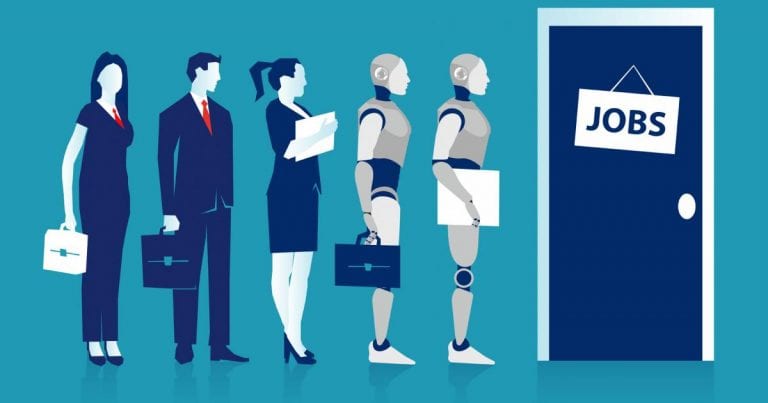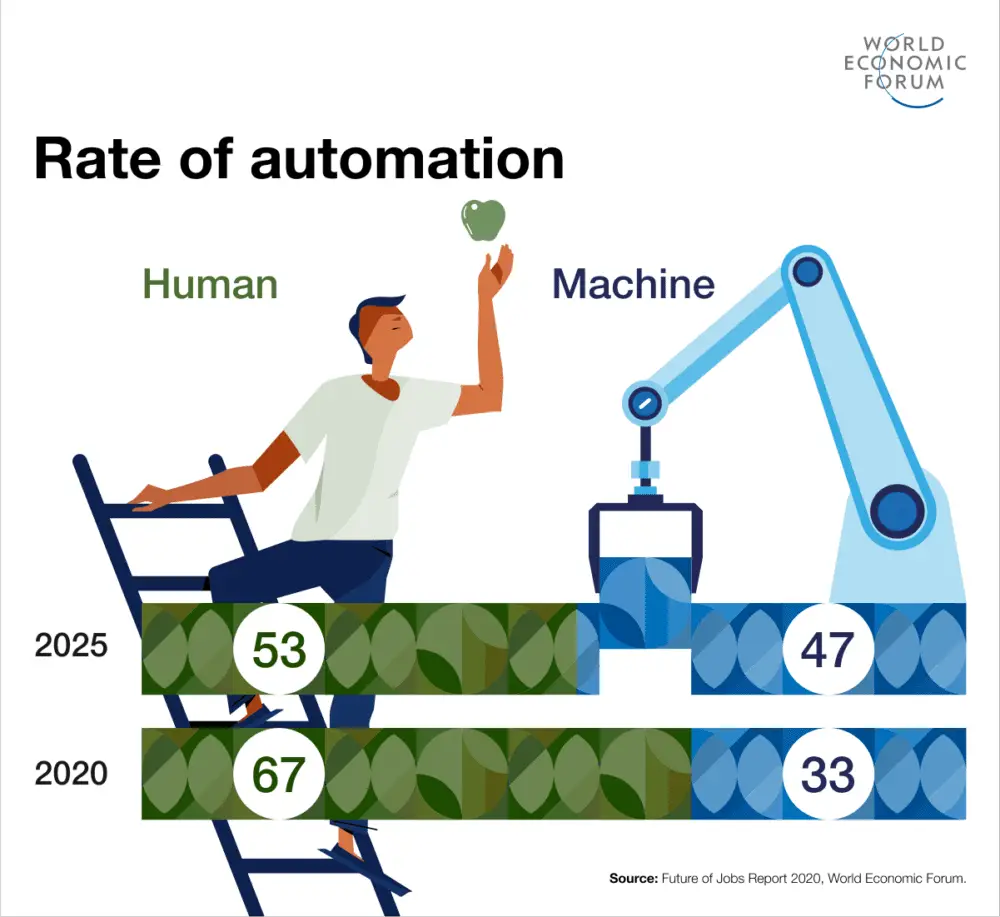AI and Employment: The Future of Work

Introduction:
The rapid proliferation of artificial intelligence (AI) is transforming industries and reshaping the global job market. As AI-powered systems become more capable, they are automating an expanding range of tasks previously carried out by human workers. This trend has sparked debates, concerns, and expectations regarding the future of work. This discourse will explore the potential impact of AI on employment, assessing both risks and opportunities.
AI and Job Displacement:
One of the primary concerns surrounding AI is its potential to displace human workers. Automation and AI-powered systems are already assuming jobs such as manufacturing, clerical work, basic customer service, and data entry tasks. As AI becomes more capable, the reach of automation may extend to more complex tasks, including programming, legal analysis, and even healthcare. This automation has the potential to result in job losses and an overall decline in the workforce.
Creating New Forms of Work:
While automation may lead to job displacement, it is also opening up new avenues for employment. AI-driven systems create demand for professionals skilled in building, maintaining, and integrating these systems into businesses. Jobs in AI development, programming, engineering, cybersecurity, and data analysis are in high demand and offer lucrative career prospects.
Increased Productivity and Efficiency:
The integration of AI into the workplace has the potential to boost productivity and efficiency. By automating tasks and optimizing processes, companies can save time, increase output, and reduce costs. The freed-up human resources can then be deployed to more strategic and creative endeavors. Additionally, AI can help facilitate remote work and enhance collaboration among distributed teams.
Reskilling and Upskilling:
The rapidly changing landscape of the labor market due to AI requires workers to reskill and upskill to avoid job displacement. This involves acquiring knowledge and expertise in emerging technologies, AI principles, data analytics, computational thinking, and problem-solving skills. Governments, educational institutions, and corporations must collaborate to provide training programs and resources to help workers make the transition to new roles.
The Human-AI Collaboration:
It is crucial to recognize that rather than complete replacement, the future of work may involve closer collaboration between humans and AI. AI systems can leverage their analytical capabilities to analyze data, make recommendations, and assist humans with complex decision-making. Humans, on the other hand, can provide creativity, empathy, social intelligence, and critical thinking, skills that are essential for tasks requiring emotional intelligence and human interaction.
Ethical and Societal Implications:
As AI continues to reshape the workplace, ethical and societal considerations come into play. Assigning liability for decisions made by AI systems, protecting workers’ rights in an automated environment, and addressing potential biases in AI algorithms are critical challenges that society must address. Additionally, policymakers must consider how to distribute the benefits of automation and AI innovation in an equitable manner.
Conclusion:
The impact of AI on employment is a multifaceted issue with both positive and negative potential. While job displacement remains a concern, the rise of AI is also creating new opportunities. Reskilling and upskilling efforts, coupled with ethical considerations and societal adjustments, are necessary for navigating the transforming employment landscape. It is imperative for individuals, organizations, and governments to adapt to the evolving nature of work to thrive in the AI-driven future.# AI and Employment: The Future of Work
Executive Summary

The integration of Artificial Intelligence (AI) across businesses and organizations introduces a new world of work opportunities and challenges. As AI automates various tasks and transforms industries, it is crucial to explore the impact on the workforce and the implications for the future of work. This comprehensive analysis delves into the key aspects surrounding AI and its influence on employment, examining trends, scenarios, and recommendations for navigating this evolving technological landscape.

Introduction
The rapid progress of AI technology raises fundamental questions about its impact on the nature and structure of work. On one hand, AI is capable of enhancing productivity, streamlining processes, and driving innovation. On the other hand, it may displace certain jobs, leading to concerns about job security and the creation of new opportunities for upskilling and reskilling the workforce. This article analyzes the complex relationship between AI and employment, providing insights into potential scenarios, challenges, and policy considerations.
Automation and Job Displacement
Automation driven by AI poses a significant challenge to traditional employment structures. Here are some important factors to consider:
- Job Displacement: AI-driven automation eliminates jobs by taking over repetitive and predictable tasks typically performed by humans.
- Impact on Industries: The impact varies across industries, with manufacturing, transportation, customer service, and data processing facing higher risks.
- Skill Gaps: A growing gap between required skills and those possessed by the workforce may lead to unemployment.
- Transition and Retraining: Efforts to retrain and upskill workers are crucial to help them adapt to new job opportunities.
New Opportunities and Job Creation
While AI may displace some jobs, it is also a source of new opportunities and job creation. Here are some key aspects to focus on:
- New Job Roles: AI creates new roles related to data analysis, AI implementation, and maintenance of AI systems.
- Increased Productivity: AI-powered automation enhances efficiency and productivity, allowing workers to focus on more creative and strategic tasks.
- Growth and Innovation: AI can drive economic growth and innovation, leading to the creation of neuen jobs in related fields.
- Reskilling and Upskilling: Investment in reskilling and upskilling programs is crucial to prepare the workforce for new job opportunities.
The Human-AI Collaboration
The future of work involves humans and AI collaborating as partners, rather than as rivals. Here are some aspects to consider:
- Complementary Strengths: Humans and AI possess distinct strengths in creativity, problem-solving, and emotional intelligence.
- Increased Efficiency: Combining AI’s analytical capabilities with human intuition and experience improves efficiency and decision-making.
- Hybrid Teams: The integration of AI in teams can result in enhanced productivity and more efficient problem-solving.
- Upskilling for Collaboration: Training programs should focus on developing skills that enable humans to work effectively with AI.
The Impact on the Workforce
The impact of AI on the workforce is multifaceted, presenting both challenges and opportunities:
- Changing Skillsets: The rise of AI requires workers to develop new skills in programming, data analysis, and digital literacy.
- New Career Pathways: AI-driven automation may lead to the emergence of new career pathways in fields such as AI engineering and data science.
- Upskilling and Reskilling: Adaptation to new roles and industries will require extensive upskilling and reskilling programs.
- Lifelong Learning: Workers should engage in continuous learning and adapt to changing skill requirements throughout their careers.
Policy and Regulatory Considerations
Governments and organizations need to address policy and regulatory issues to ensure a smooth transition into an AI-driven workforce:
- Safety Regulations: Ensuring the safe and responsible use of AI in workplaces is vital for the protection of workers and consumers.
- Workforce Development: Governments should invest in programs that support reskilling, upskilling, and lifelong learning initiatives.
- Ethical Considerations: Establishing ethical guidelines for the development, deployment, and use of AI ensures fair treatment and minimal bias.
- Collaborative Partnerships: Public-private partnerships can promote innovation and address challenges related to AI implementation.
Conclusion
The integration of AI in the workplace presents a complex and ever-changing landscape. Organizations and policymakers must work together to create a future of work that embraces the benefits of AI while addressing the challenges it brings. By investing in upskilling, reskilling, and lifelong learning, we can foster a workforce that is adaptable, resilient, and capable of collaborating with AI to drive progress and innovation. Embracing these opportunities and navigating the technological advancements responsibly will ensure a positive and transformative integration of AI in the workplace, shaping a future of work that is more equitable, sustainable, and rewarding for all.
Keyword Phrase Tags
- AI Impact on Jobs
- Future of Work
- Automation and Employment
- Upskilling and Reskilling
- Human-AI Collaboration

This article provides a valuable overview of the potential impact of AI on the future of work. The discussion of the benefits and challenges of AI is well-balanced and thought-provoking. I especially appreciate the emphasis on the importance of preparing for the future of work by investing in education and training.
I found this article to be overly optimistic about the potential of AI to create new jobs. While it is true that AI can automate certain tasks, it is also likely to displace workers in many industries. We need to be realistic about the challenges that AI poses to the workforce and develop strategies to address them.
The article makes several good points about the potential benefits of AI for business and society. I particularly agree with the author’s argument that AI can help us to solve some of the world’s most pressing problems, such as climate change and poverty. However, I believe that the article underestimates the ethical challenges that AI poses. We need to be careful to ensure that AI is used for good and not for evil.
I disagree with the author’s claim that AI will inevitably lead to mass unemployment. While it is true that AI can automate certain tasks, it is also likely to create new jobs that require different skills and knowledge. I believe that the future of work will be shaped by a combination of AI and human ingenuity.
I found the article’s discussion of the potential impact of AI on the future of work to be somewhat ironic. On the one hand, the author argues that AI will create new jobs and opportunities. On the other hand, the author also acknowledges that AI could lead to mass unemployment. I believe that the future of work is uncertain and that it is difficult to predict the exact impact of AI.
The article’s claim that AI will lead to a utopia where everyone has a fulfilling and meaningful job is simply wishful thinking. AI is more likely to exacerbate existing inequalities and create a world where the rich get richer and the poor get poorer. We need to be realistic about the challenges that AI poses and develop strategies to address them.
I found the article’s discussion of the potential impact of AI on the future of work to be highly comical. The author seems to think that AI will solve all of our problems and create a perfect world. I believe that the reality is likely to be much more complicated and that AI could pose significant challenges to our society.
This article was very well-written and informative. I especially liked the discussion of the potential benefits of AI for business and society. I believe that AI has the potential to make the world a better place, but only if we use it wisely.